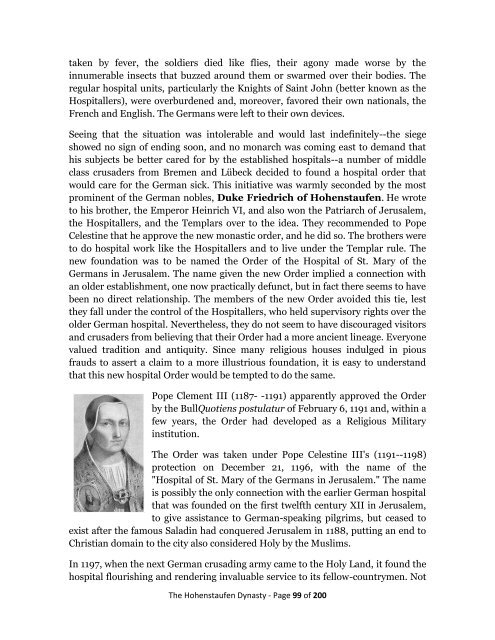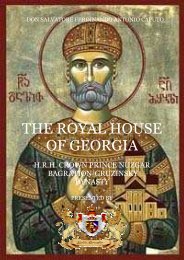here - Nobility Associations
here - Nobility Associations
here - Nobility Associations
Create successful ePaper yourself
Turn your PDF publications into a flip-book with our unique Google optimized e-Paper software.
taken by fever, the soldiers died like flies, their agony made worse by the<br />
innumerable insects that buzzed around them or swarmed over their bodies. The<br />
regular hospital units, particularly the Knights of Saint John (better known as the<br />
Hospitallers), were overburdened and, moreover, favored their own nationals, the<br />
French and English. The Germans were left to their own devices.<br />
Seeing that the situation was intolerable and would last indefinitely--the siege<br />
showed no sign of ending soon, and no monarch was coming east to demand that<br />
his subjects be better cared for by the established hospitals--a number of middle<br />
class crusaders from Bremen and Lübeck decided to found a hospital order that<br />
would care for the German sick. This initiative was warmly seconded by the most<br />
prominent of the German nobles, Duke Friedrich of Hohenstaufen. He wrote<br />
to his brother, the Emperor Heinrich VI, and also won the Patriarch of Jerusalem,<br />
the Hospitallers, and the Templars over to the idea. They recommended to Pope<br />
Celestine that he approve the new monastic order, and he did so. The brothers were<br />
to do hospital work like the Hospitallers and to live under the Templar rule. The<br />
new foundation was to be named the Order of the Hospital of St. Mary of the<br />
Germans in Jerusalem. The name given the new Order implied a connection with<br />
an older establishment, one now practically defunct, but in fact t<strong>here</strong> seems to have<br />
been no direct relationship. The members of the new Order avoided this tie, lest<br />
they fall under the control of the Hospitallers, who held supervisory rights over the<br />
older German hospital. Nevertheless, they do not seem to have discouraged visitors<br />
and crusaders from believing that their Order had a more ancient lineage. Everyone<br />
valued tradition and antiquity. Since many religious houses indulged in pious<br />
frauds to assert a claim to a more illustrious foundation, it is easy to understand<br />
that this new hospital Order would be tempted to do the same.<br />
Pope Clement III (1187- -1191) apparently approved the Order<br />
by the BullQuotiens postulatur of February 6, 1191 and, within a<br />
few years, the Order had developed as a Religious Military<br />
institution.<br />
The Order was taken under Pope Celestine III's (1191--1198)<br />
protection on December 21, 1196, with the name of the<br />
"Hospital of St. Mary of the Germans in Jerusalem." The name<br />
is possibly the only connection with the earlier German hospital<br />
that was founded on the first twelfth century XII in Jerusalem,<br />
to give assistance to German-speaking pilgrims, but ceased to<br />
exist after the famous Saladin had conquered Jerusalem in 1188, putting an end to<br />
Christian domain to the city also considered Holy by the Muslims.<br />
In 1197, when the next German crusading army came to the Holy Land, it found the<br />
hospital flourishing and rendering invaluable service to its fellow-countrymen. Not<br />
The Hohenstaufen Dynasty - Page 99 of 200



